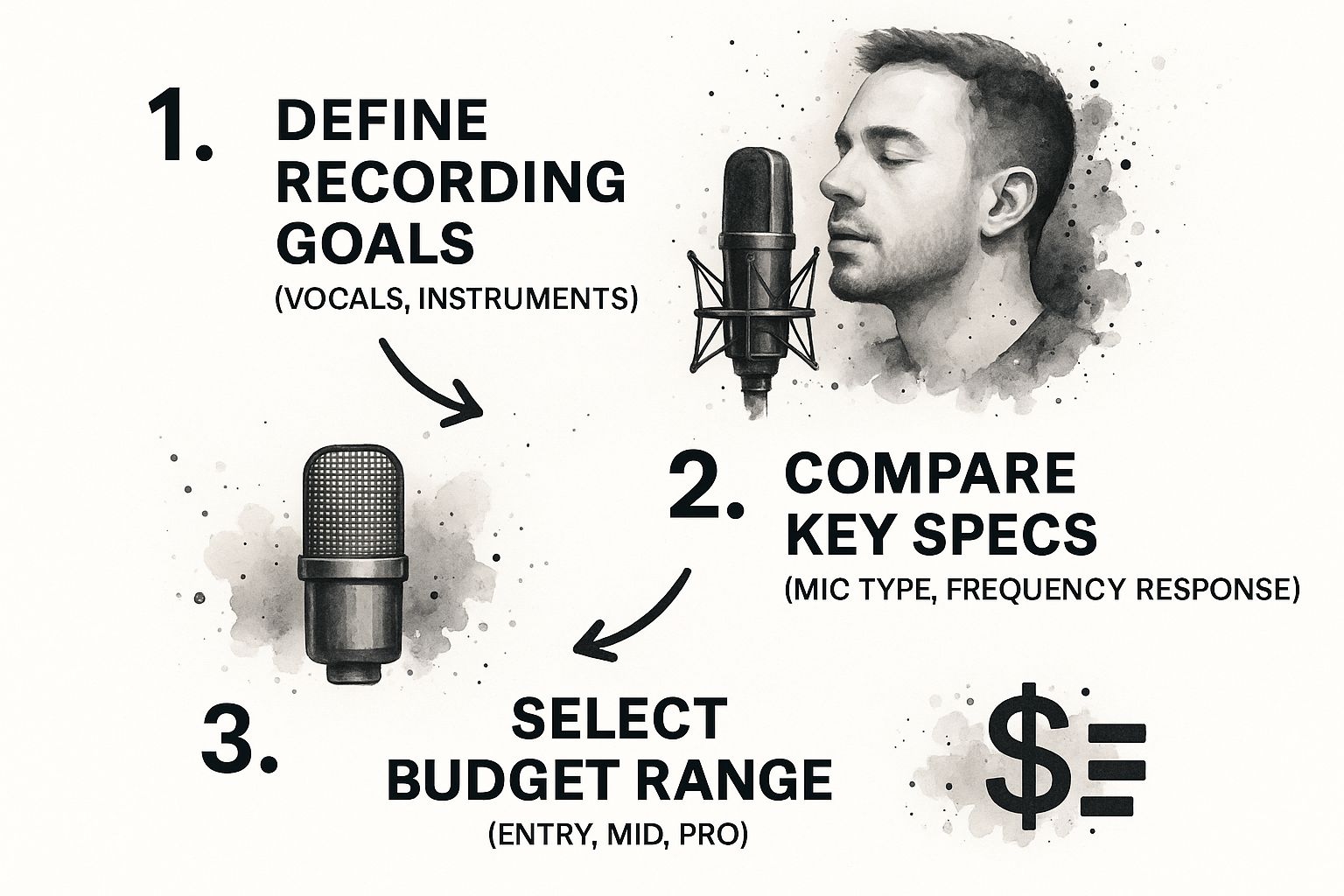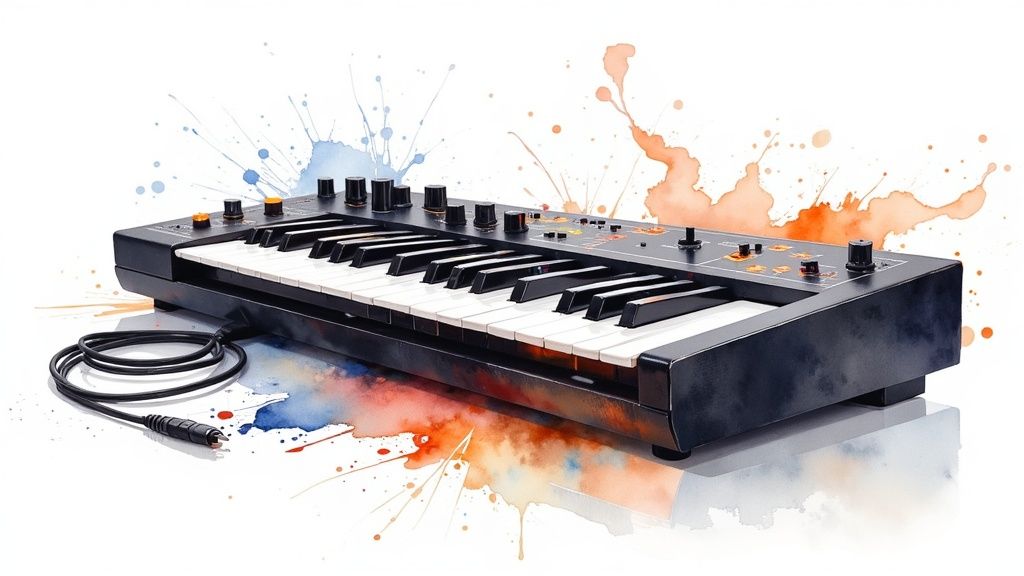
Ready to turn simple text into custom sound? It all begins with getting comfortable in a text-to-sound tool like SFX Engine, figuring out how your credits work, and then writing that first descriptive prompt. This is your first real step into AI sound generation, and it's surprisingly intuitive.
 Diving into AI-powered sound creation is a blast, and tools like SFX Engine are built to get you started quickly. You can forget about the steep learning curve of traditional sound design software. The whole point here is to translate your ideas into high-quality audio through simple, direct instructions. You describe it, the AI creates it.
Diving into AI-powered sound creation is a blast, and tools like SFX Engine are built to get you started quickly. You can forget about the steep learning curve of traditional sound design software. The whole point here is to translate your ideas into high-quality audio through simple, direct instructions. You describe it, the AI creates it.
Your first session is all about exploring the interface and seeing what resources you have. This initial hands-on time is key for building confidence and sets the stage for more complex sound crafting later on. It’s also worth recognizing that this is just one piece of a much larger shift, where AI automation services are changing how creative work gets done across the board.
Before you jump into writing prompts, let's talk about credits. Think of them as your creative currency for making audio. In SFX Engine, generating a sound costs one credit. This straightforward system puts you in the driver's seat of your usage, freeing you from a rigid monthly subscription.
Here's how I recommend managing your credits, especially when you're starting out:
Being smart with your credits is what gives you the freedom to play around and experiment. That freedom is absolutely essential for discovering how to create sounds that are truly unique and perfect for your project.
This credit-based approach is pretty common in the world of generative AI tools. Getting the hang of it early means you can spend more of your mental energy on the fun part: being creative. If you want to explore more tools and see how they stack up, our complete https://sfxengine.com/blog/ai-sound-effect-generator-guide gives you a much broader look. With this foundation, you’re ready to start making the exact audio you need.
At its core, getting great audio out of an AI sound generator all comes down to the quality of your prompt. If you just type in "explosion," you'll get something generic back. But a truly detailed prompt? That’s how you get the exact sound you’re hearing in your head. This is where your creativity takes the driver's seat, shaping the technology to produce a rich, textured audio experience.
Think of it like being a film director. You wouldn't just tell an actor to "walk." You’d give them specifics. The same logic applies here. Instead of asking for a generic "footstep," try something like "heavy crunch of a leather boot on dry autumn leaves" or "the soft patter of bare feet on a wet stone floor." Every word you add is another layer of instruction, guiding the AI toward a far more specific and believable result.
It’s about more than just nouns and verbs. Weave in descriptive adjectives and environmental context to paint a full sonic picture for the AI.
From my experience, the most effective prompts usually nail three key elements:
Layering these details is what takes a simple idea and turns it into a prompt that can generate a professional-quality sound effect.
I've learned that the difference between a good sound and a great one is almost always in the prompt's specificity. A tiny change, like adding an environmental detail, can completely transform the final audio, giving it a sense of place and realism it otherwise lacked.
I've created a little table to show you what this looks like in practice. It’s a simple way to visualize how you can level up your prompts from basic to much more effective.
| Sound Idea | Basic Prompt | Advanced Prompt |
|---|---|---|
| Car Door | Car door closing | The heavy, solid thud of a luxury sedan door closing in an underground parking garage |
| Sword | Sword swing | A sharp, high-pitched whoosh of a steel katana slicing through the air, with a slight metallic ring |
| Fire | Fire burning | The low, steady crackle and pop of a large bonfire at night, with a gentle wind |
See the difference? The advanced prompts give the AI so much more to work with, leading to a richer, more nuanced sound. It’s a simple shift in thinking that pays off big time.
The logic is similar to how you'd choose audio gear—you define your goal first, then get into the specifics. This visual breaks down that kind of workflow.

Just as starting with a clear purpose helps you pick the right equipment, starting with a clear, detailed sound idea is the most reliable way to get the audio you want from the AI.
To really get ahead, it's also smart to keep an eye on the future of prompt engineering. The skills you build today by crafting detailed prompts are foundational for whatever comes next in AI-powered audio creation.

A well-crafted prompt gets you in the ballpark, but the real magic happens when you start tweaking the parameters. This is where the artistry comes in. Think of these controls as the faders on a mixing board—they give you the granular control needed to sculpt a good sound into the perfect one for your project.
Getting comfortable with these settings is what separates a novice from a pro. It’s how you add that final polish and create truly unique audio.
One of the most fundamental yet powerful tools at your disposal is the Duration slider. This directly controls the length of your sound effect, and getting it right is crucial for matching the audio to your visuals.
Getting the timing right helps sell the reality of the sound within its scene.
The right duration can make or break an effect. A footstep that drags on too long feels unnatural, while a thunderclap that cuts off too soon loses all its power. Always ask yourself: "How long would this sound last in the real world?"
The Variety slider is an absolute game-changer, especially when you need multiple versions of a single sound. Instead of manually creating slight variations, this feature does the heavy lifting for you.
Let’s say you need footsteps for a character walking across a gravel path. In reality, no two steps would sound identical. By cranking up the variety, the AI will generate subtly different footsteps each time, injecting a layer of organic realism that would be tedious to create from scratch. It's a massive time-saver and a hallmark of the best AI sound effect generators of 2024.
This same logic is perfect for any sound that repeats—raindrops, a volley of arrows, or the clatter of falling debris. When you pair a strong prompt with smart parameter adjustments, you're not just generating sounds; you're directing them.
You’ve done the hard work and prompted the perfect audio file. That's a great feeling, but now you've got to get that sound out of SFX Engine and into whatever you're building—be it a film, a podcast, or a video game. This last step is all about making smart choices with your file formats and, just as importantly, staying organized.
The first big decision is whether to export as a WAV or an MP3. Honestly, the right choice completely depends on where the sound is headed next.
If you're working on something that demands top-tier audio quality, like professional film sound design or a track destined for a music release, you should always go with WAV. It’s an uncompressed format, which means you get 100% of the original audio data. This gives you the highest possible fidelity and the most flexibility for any future editing or mixing. No compromises.
Now, if you’re building something where file size is the main enemy—think mobile games or web apps—then MP3 is your friend. MP3s use compression to drastically shrink the file, which is a lifesaver for keeping loading times fast and performance snappy. You do lose a tiny bit of audio quality in the process, but for most applications, the end-user will never notice the difference.
My personal rule of thumb is pretty simple: WAV for production, MP3 for delivery. I always keep the high-quality WAVs as my master files in an archive. I only ever create an MP3 when I absolutely need that smaller file size for the final product.
As you start cranking out more and more custom sounds, your library can get out of control fast. A solid, consistent naming convention is the best way to prevent a total mess. Trust me on this. I've learned it the hard way.
A good system should tell you what the sound is, any specific variations, and where it came from.
For instance, a file name like this is incredibly useful:
Footstep_Gravel_Boot_Slow_v01.wav
With a name like that, you know exactly what you're getting without even having to listen to it. This kind of organization seems like a small thing, but it will save you countless hours of searching and frustration down the road. And hey, if you need to bulk up your library beyond your own creations, you can always explore a catalog of pre-made royalty-free sound effects to fill in any gaps.

To really get the most out of today's AI-powered audio tools, it helps to know how we got here. The journey from clunky mechanical gadgets to intelligent software reveals a clear path, with every new technology making sound design a little easier and a lot more creative.
It all started with just trying to capture sound waves. In the mid-19th century, the first devices could only create a visual recording of vibrations. It wasn't until Thomas Edison's phonograph in 1877 that we could finally record and play back sound. This kicked off the Acoustic Era, where everything was done mechanically, long before electrical amplification was even a concept. These early steps were the foundation for everything that followed.
The Electrical Era changed everything by introducing microphones and amplification. Suddenly, sound could be made louder and captured with more nuance. Then came the Magnetic Era, giving us high-fidelity tape recording and, for the first time, the ability to physically cut and splice tape to edit audio. This was a massive leap in control for creators.
The real game-changer, though, was the Digital Era, which began around 1975. Sound was no longer tied to a physical medium; it became data. Just ones and zeros. This shift meant we could manipulate audio on computers with a level of flexibility that was previously unimaginable. It’s this digital foundation that modern tools like SFX Engine are built on.
The ability to generate complex, high-quality audio from a simple text prompt is the direct result of over 150 years of technological innovation. It represents a fundamental shift from capturing existing sounds to creating entirely new ones from imagination.
The principles driving AI audio are part of a much bigger picture. Understanding how artificial intelligence is being used across different creative fields can give you a real edge. This is just one part of the broader story of AI for content creation that is making waves in almost every industry.
https://www.youtube.com/embed/CN6cYkvd__8
Diving into AI for sound creation is exciting, but it naturally brings up a lot of questions. For most creators, this is brand-new territory. Let's walk through some of the most common things people ask, so you can stop wondering and start making amazing audio with a tool like SFX Engine.
Getting these fundamentals down is what separates random button-pushing from intentional, professional-sounding design.
Honestly, the range is massive. The AI is surprisingly versatile, handling everything from hyper-realistic foley to sounds that are completely out of this world.
It really shines across a few key areas:
The real limit isn't the technology—it's how well you can describe what you want to hear. Specificity is your best friend. The more details you feed the AI about the materials, the action, and the environment, the more unique and believable your sound will be.
Not at all. In fact, thinking like a sound engineer can sometimes be less effective than thinking like a storyteller. You don't need a technical vocabulary to get incredible results.
The best approach is to describe the sound you're imagining as if you were writing it in a script or a novel. Use powerful verbs and descriptive adjectives. Instead of a generic prompt like "sword hit," paint a full picture: "the sharp, metallic clang of a steel longsword striking a heavy oak shield inside a reverberant stone hall."
By breaking the sound down into its core components—the initial impact, the materials involved, and the echo of the space—you give the AI a clear blueprint. This simple shift in perspective is the secret to getting prompts right.
Yes, and this is where you can save a ton of time. A well-written prompt can produce a single audio file containing multiple, distinct sound elements that all work together.
For instance, a prompt like, "heavy rain drumming on a car roof, with the rhythmic thump of windshield wipers and distant thunder rumbling," can generate one cohesive soundscape. The key is to describe how the sounds relate to each other. Using words like "distant," "muffled," "underneath," or "rhythmic" gives the AI instructions on how to mix the layers, setting the right presence and volume for each element.
The technology has come a long way. Some of the latest audio models can even fuse totally unrelated concepts—imagine a trumpet that barks like a dog. It just goes to show you how much creative ground there is to explore.
Ready to start crafting your own unique, royalty-free audio? Try SFX Engine today and bring your sonic ideas to life. Get started for free at sfxengine.com.
Article created using Outrank